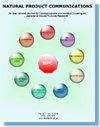对经证实可作为镰状细胞病治疗药物的药用植物及其化合物的系统回顾
IF 1.4
4区 医学
Q4 CHEMISTRY, MEDICINAL
引用次数: 0
摘要
传统医学中用于治疗镰状细胞病的一些植物已通过药理学验证,以确定其抗镰状细胞病的特性。然而,目前还没有对支持这些植物用于镰状细胞病治疗的证据进行全球性的系统综述。本研究旨在对药理学证据进行系统综述,以突出可用于新型抗镰状细胞病药物的物种、属和一些植物化学物质。研究采用了系统综述和元分析首选报告项目(PRISMA)指南。分析纳入了 2000 年至 2022 年发表的英文文章。文献检索涵盖 411 篇出版物,其中 82 篇符合条件。一半以上(53.65%)的文章发表于 2016 年至 2022 年。来自非洲的抗酸化研究占86.58%,其中一半以上来自尼日利亚,12.20%来自亚洲,只有1.22%来自欧洲。豆科(Fabaceae)、大戟科(Euphorbiaceae)和葵科(Annonaceae)是发表论文最多的三个植物科,而 Zanthoxylum 和 Terminalia 是发表论文最多的属。木瓜(Carica papaya)和鸡冠花(Terminalia catappa)是报告最多的物种。西克令反转(n = 33/82)和血红蛋白聚合研究(n = 29/82)是报道最多的检测方法。苯甲酸衍生物、硬脂酸丁酯、鞣花酸衍生物和一些五环三萜类化合物是唯一通过抗镰刀菌活性验证的植物衍生化合物。共有 117 种植物具有抗酸洗活性。对具有抗镰状细胞病特性的次生代谢物进行的研究有限,这些次生代谢物可作为开发治疗镰状细胞病的新型药物的支架。本文章由计算机程序翻译,如有差异,请以英文原文为准。
A Systematic Review of Medicinal Plants and Their Compounds Validated as Agents for the Management of Sickle Cell Disease
Some plants used in traditional medicine to manage sickle cell disease have been validated pharmacologically to ascertain their anti-sickling properties. However, there is no global systematic review of the evidence in support of their use for sickle cell management. This research aimed to conduct a systematic review of the pharmacological evidence to highlight species, genera, and some phytochemicals which could be primed for novel anti-sickling medications. The Preferred Reporting Items for Systematic Review and Meta-Analyses (PRISMA) guidelines were used. Articles in English, published from 2000 to 2022 were included in the analysis. The literature search covered 411 publications of which 82 were found to be eligible. More than half (53.65%) of the articles were published from 2016 to 2022. Anti-sickling research from Africa accounted for 86.58% of the publications, with more than half coming from Nigeria, 12.20% from Asia and only 1.22% from Europe. The Fabaceae, Euphorbiaceae, and Annonaceae were the top three plant families whereas Zanthoxylum and Terminalia were the most reported genera. Carica papaya and Terminalia catappa were the most reported species. Sickling reversal ( n = 33/82) and hemoglobin polymerization studies ( n = 29/82) were the most reported assays. Benzoic acid derivatives, butyl stearate, ellagic acid derivatives, and some pentacyclic triterpenoids were the only plant derived compounds validated for anti-sickling activities. A total of 117 plant species with anti-sickling activities were documented. Studies on secondary metabolites with anti-sickling properties to serve as scaffolds for novel drug development for sickle cell management were limited.
求助全文
通过发布文献求助,成功后即可免费获取论文全文。
去求助
来源期刊

Natural Product Communications
工程技术-食品科技
CiteScore
3.10
自引率
11.10%
发文量
254
审稿时长
2.7 months
期刊介绍:
Natural Product Communications is a peer reviewed, open access journal studying all aspects of natural products, including isolation, characterization, spectroscopic properties, biological activities, synthesis, structure-activity, biotransformation, biosynthesis, tissue culture and fermentation. It covers the full breadth of chemistry, biochemistry, biotechnology, pharmacology, and chemical ecology of natural products.
Natural Product Communications is a peer reviewed, open access journal studying all aspects of natural products, including isolation, characterization, spectroscopic properties, biological activities, synthesis, structure-activity, biotransformation, biosynthesis, tissue culture and fermentation. It covers the full breadth of chemistry, biochemistry, biotechnology, pharmacology, and chemical ecology of natural products.
Natural Product Communications is a peer reviewed, open access journal studying all aspects of natural products, including isolation, characterization, spectroscopic properties, biological activities, synthesis, structure-activity, biotransformation, biosynthesis, tissue culture and fermentation. It covers the full breadth of chemistry, biochemistry, biotechnology, pharmacology, and chemical ecology of natural products.
 求助内容:
求助内容: 应助结果提醒方式:
应助结果提醒方式:


